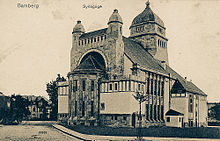Synagogues in Bamberg
From the Middle Ages onwards there were several synagogues in Bamberg one after the other . Throughout the centuries they were and are symbols of settlement points for the Jewish community in Bamberg .
The first synagogue (today: Judenstrasse 1) existed for an unknown time and was the center of the Jewish settlement which existed until 1348. After the expropriation and expulsion of the Jews under Friedrich I von Hohenlohe , a Catholic St. Mary's Church was built in place of the synagogue in 1422 . Today's building complex was built in the middle of the 15th century. Secularized as a church in 1803 , it was a Baptist Church from 1946 to 2008 .
The second synagogue was used between 1430 and 1478, and then possibly from 1520 to 1660; in between the Jews had been driven out of the city. After Jews had settled in Bamberg again, the building was built in Hellerstrasse in a back garden - however, it is not known today exactly where the building was.
The third synagogue was built in Generalsgasse number 15. Around 1660, a building complex was rented here as a synagogue and community center, which in 1668 became the property of the city of Bamberg. The buildings could then be officially rented by the city. Ten years later, the buildings were expanded and renovated and in 1694 everything was available for purchase. The synagogue was used until 1853 when it finally became too small. The house itself no longer stands today. It fell victim to the new Theatergasse buildings in the 1980s.
The massive renovation and expansion in 1853 was designated as an independent new building and thus dubbed the fourth synagogue. But by 1910 this building had become too small again, which is why the Jewish community refrained from renting various halls for large celebrations and planned another new building.
With a large amount of donations from the population (including non-Jews), a dignified fifth synagogue was built on Herzog-Max-Strasse between 1908 and 1910. Its tower was 37 meters high and was clearly visible from afar. The Bamberger Tagblatt wrote at the opening on September 11, 1910:
"This is how these stones, put together by an ingenious hand, bear witness to the architectural and monumental beauty and adornment of the whole city."
During the pogroms of November 9th to 10th, 1938, she was sacked under mayor and district leader Lorenz Zahneisen and the chairman of the Jewish community, Willy Lessing , was fatally injured by the mob while trying to save the Torah scrolls . The Bamberg fire brigade was prevented from extinguishing the fire. The synagogue ruins were demolished a year later at the expense of the Jewish population. Zahneisen was convicted of breaking the peace and arson after the war.
After the re-establishment of the Jewish community from a few survivors of the Bamberg pre-war community and Jews who had settled in Bamberg due to displacement, the sixth synagogue was set up in a former office building at Willy-Lessing-Strasse 7 in 1951, and in 1963 it was rebuilt and enlarged.
On June 1, 2005, the Jewish community in Bamberg was able to inaugurate its seventh synagogue. A community center with a synagogue, mikveh, sukka, hall, teaching house and other infrastructure was created from a former building of the sewing silk factory in Willy-Lessing-Straße 7a. The establishment of the sixth synagogue was taken over in the new building complex for use as a weekday synagogue.
literature
- Michael Imhof (Ed.): Piety and Art in Franconia. BVB, Bamberg 1994, ISBN 3-87052-409-X .
- Herbert Loebl : Jews in Bamberg. Franconian Day, Bamberg 1999, ISBN 3-928648-48-9 .
Web links
- Israelitische Kultusgemeinde Bamberg (about the synagogues especially menu item history )
Individual evidence
- ↑ Axel Polnik: The Bayreuth fire brigades in the Third Reich: The fire protection in the Gau capital Bayreuth. , Books on Demand 2011, ISBN 3842395639 , p. 179
Coordinates: 49 ° 53 '24 " N , 10 ° 53' 47" E


